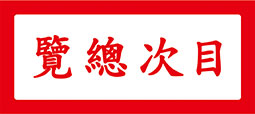In the 34th year of the Republic (1945), the Republic of China, the United States, the United Kingdom and the Soviet Union founded the United Nations. When the Republic of China withdrew from the United Nations in the 60th year of the Republic (1971), she had occupied the position of Permanent Member of the Security Council for twenty six years.
By 1971, the Chinese communists had already unleashed the Cultural Revolution in mainland China for five years, during this time 100,000,000 Chinese were purged, 20,000,000 were killed. Mainland China was indeed a blood drenched hell. But in that year, the United States led the pack to propitiate the Chinese communists, and fixed an entourage of countries to usher the Chinese communists into the United Nations, and compelled the removal of the Republic of China from the United Nations. To the world, there is no trace of righteousness. To diplomacy, it is an insult to a founder, a betrayal of a World War ally. The United States relishes the delivery of eulogies about democracy and human rights, yet when driven by interests, her course can change any minute.
We hereby present A Dinner Programme from the Early Years of the Founding of the United Nations. Surely to retrace the laurels of the past, yet hopeful too that this can offer caution and rally. Knowing there is nothing but national interests in this world, seek nothing else but self-assurance and self-reliance.
Curatorial and Editorial Department

Detail of Dinner Programme from the early years of the founding of the United Nations.
There is a yellowing vintage Dinner Programme in the collection of the Studio of Prunus Ode that invokes and recalls the illustrious history of the founding of the United Nations by the Republic of China.
On 25th April in the 34th year of the Republic (1945), the opening ceremony of the United Nations Conference on International Organization took place in San Francisco. It is also known as the San Francisco Conference. Delegates from fifty countries worked together to formulate the United Nations Charter. The Republic of China, the United States, the United Kingdom and the Soviet Union are the four founding members of the United Nations. The Republic of China was also one of the five members of the United Nations Security Council. On 26th June 1945, delegates from the Republic of China, the United States, the United Kingdom, the Soviet Union and the other member countries signed the United Nations Charter. The Republic of China is the first country to fight against the invasion of an Axis power. In order to convey unanimous respect by the international community, the Republic of China was invited to be the first signatory. The delegation of the Republic of China, including head delegate Koo Vi Kyuin (顧維鈞 1888-1985) and the other seven delegates: Wang Ch’ung-hui (王寵惠 1881-1958), Wei Tao-ming (魏道明 1899-1978), Wu Yi-fang (吳貽芳 1893-1985), Li Huang (李璜 1895-1991), Chang Chün-mai (張君勱 1887-1969), Tung Pi-wu (董必武 1886-1975), Hu Lin (胡霖 1889-1949), preceded those delegates from other member countries in the signing of the United Nations Charter. On 24th October in the same year, the United Nations Charter came into effect after being ratified by the majority of the member countries.

Koo Vi Kyuin, head delegate of the Chinese Delegation, was the first to sign the United Nations Charter at the San Francisco Conference on 26th June 1945. Photograph courtesy United Nations Media Centre

Delegates of the Chinese Delegation signed the United Nations Charter on 26th June 1945. The signatures on the Charter are by : Koo Vi Kyuin (顧維鈞), Wang Ch’ung-hui (王寵惠), Wei Tao-ming (魏道明), Wu Yi-fang (吳貽芳), Li Huang (李璜), Chang Chün-mai (張君勵), T’ung Pi-wu (董必武) and Hu Lin (胡霖). Photograph courtesy United Nations Media Centre
The first meeting of the first session of the United Nations General Assembly took place between 10th January to 14th February 1946, at the Methodist Central Hall in London. Delegates from fifty one countries attended.
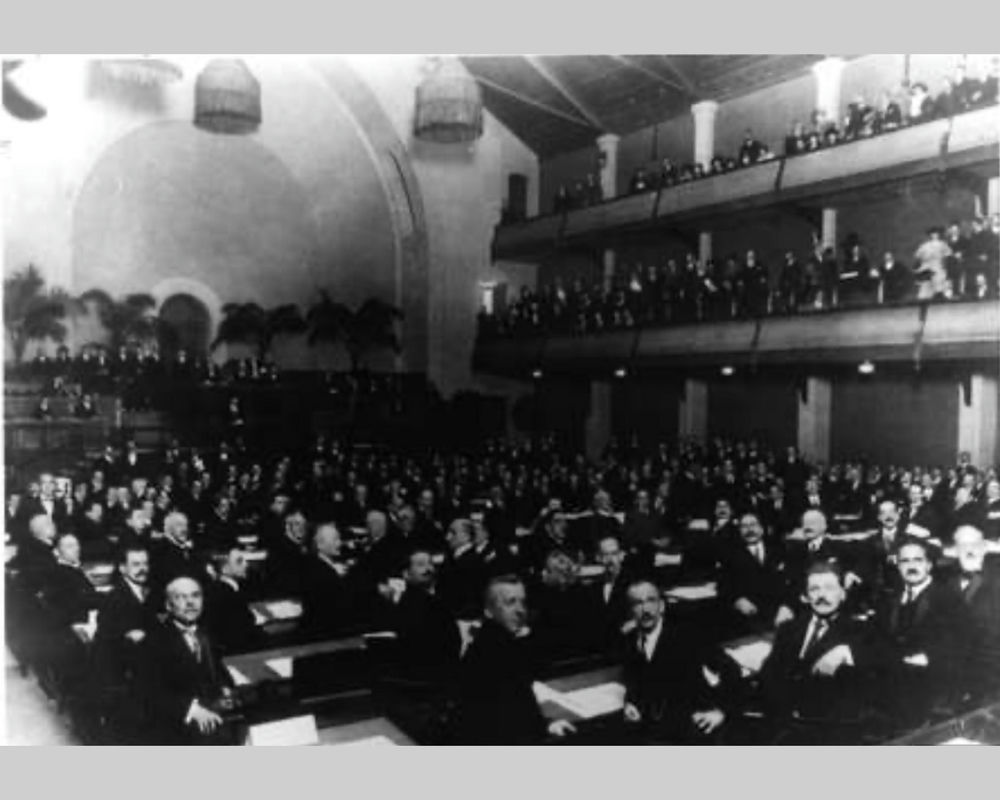
The first meeting of the first session of the United Nations General Assembly at the Methodist Central Hall in London on 10th January 1946.

Koo Vi Kyuin, head delegate of the Chinese Delegation, seated in the middle of the front row attending the United Nations Security Council meeting on 10th January 1946. Photograph courtesy United Nations Archives
The second meeting of the first session of the United Nations General Assembly took place between 23rd October to 15th December 1946, at the former World’s Fair site in Flushing Meadows-Corona Park.
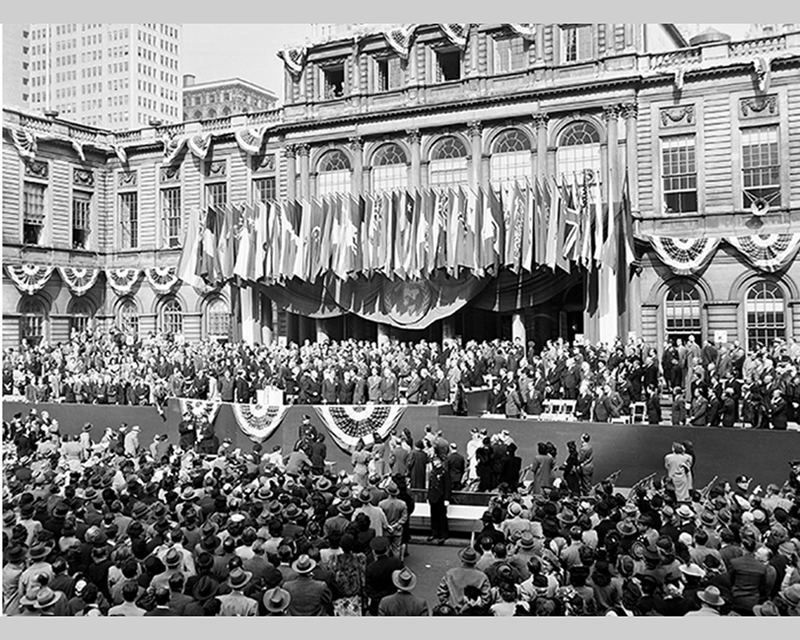
On 23 rd October 1946, Deputy Mayor Thomas Corcoran welcomed delegates to the first General Assembly at New York City Hall. Later that day, the second session of the first General Assembly opened at the site in Flushing Meadows. Photograph courtesy New York City Archives
In the evening of 11th November 1946, the Foreign Press Association of the United States invited the heads of delegations to the General Assembly and the Security Council of the United Nations to a dinner banquet at the Waldorf-Astoria Hotel in New York. The Dinner Programme in the collection of the Studio of Prunus Ode is a tri fold brochure, the inner pages are decorated with caricatures, drawn by Alois Derso and Emery Kelen, the illustration artists. On the blank panel at the back of the Dinner Programme, there are three handwritten signatures, one by Koo Vi Kyuin, head delegate of the Republic of China, one by Ernest Bevin, Foreign Secretary of the United Kingdom, and one by Alexandre Parodi, head delegate of the French Republic.
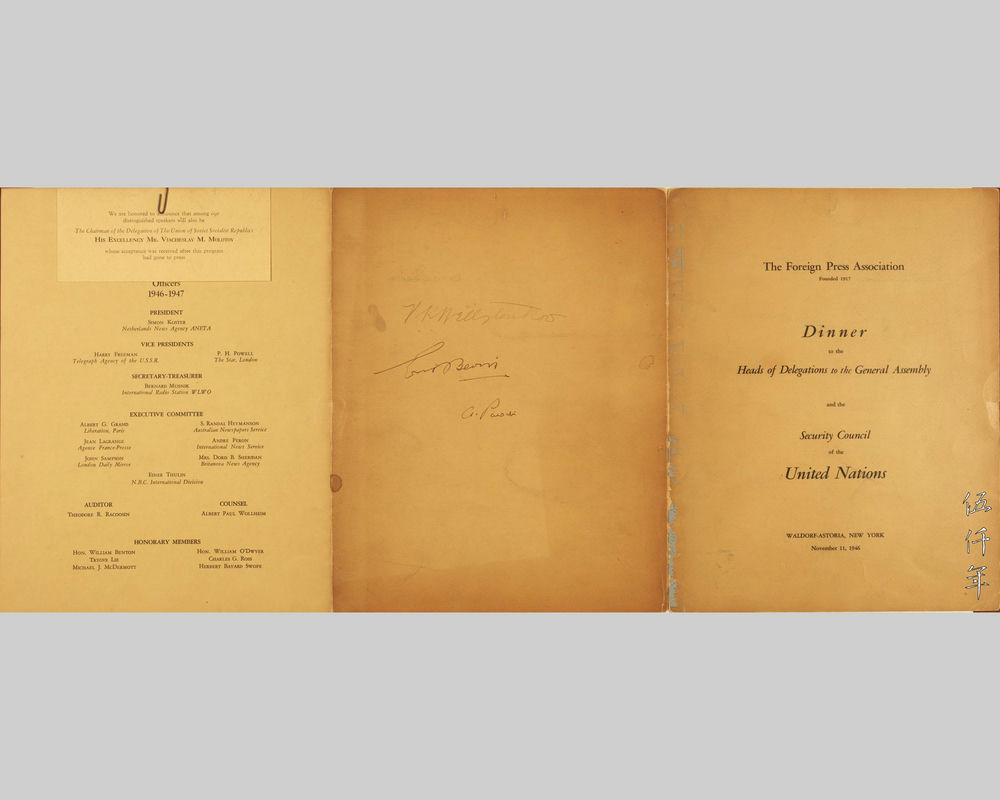
The outer three panels of the Dinner Programme

The inner three panels of the Dinner Programme

Koo Vi Kyuin, head delegate of the Chinese Delegation; Ernest Bevin, British Foreign Secretary; Alexandre Parodi, head delegate of the French Delegation; signed the back of the Dinner Programme.
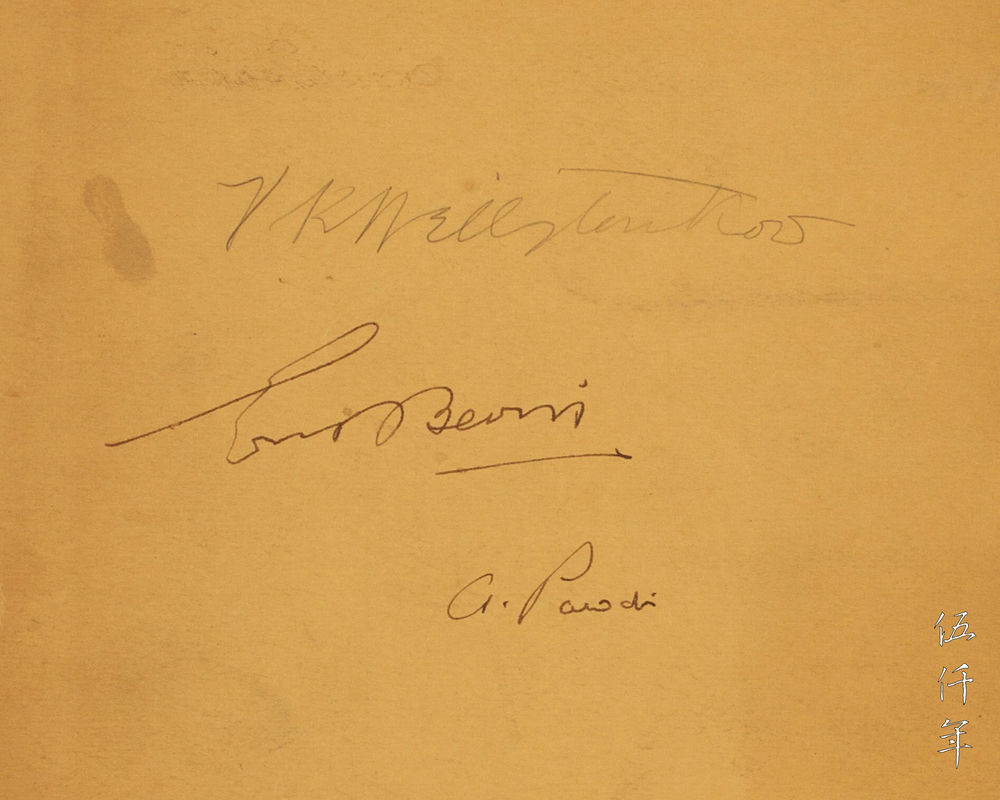
Signatures by Koo Vi Kyuin, Ernest Bevin and Alexandre Parodi
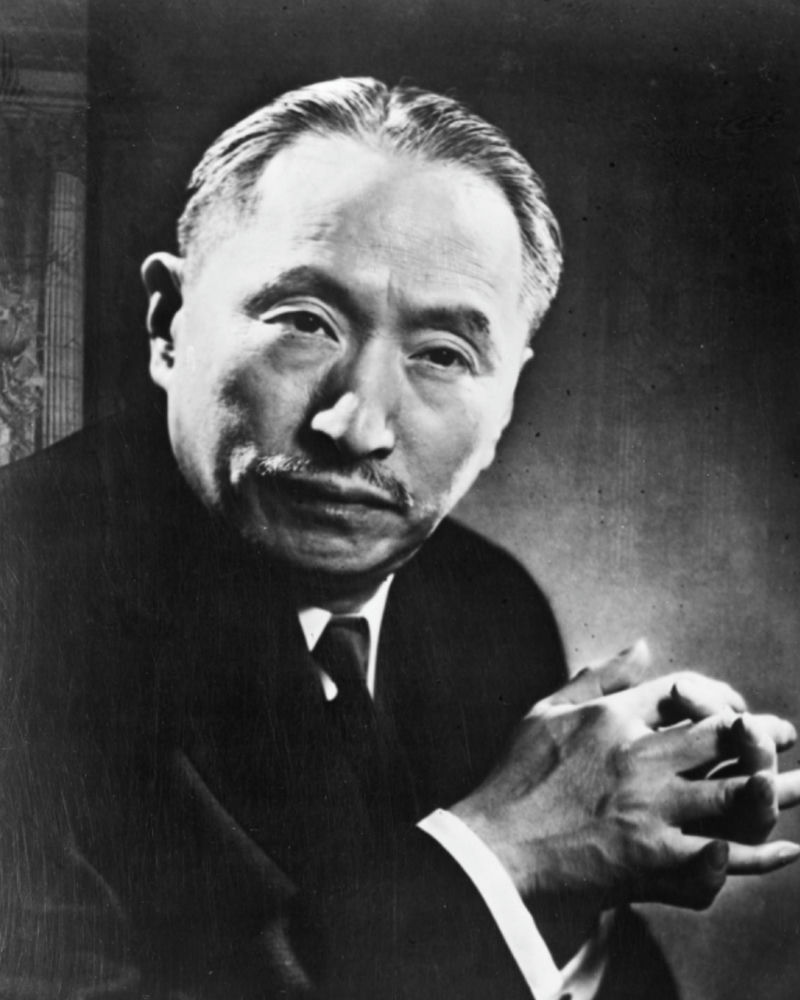
Portrait of Koo Vi Kyuin
There is no record regarding the number of head delegates to the General Assembly and the Security Council who attended the dinner banquet on 11th November. However it is possible to make an approximation. In the Studio of Prunus Ode, there is a copy of the Seating Arrangement for the luncheon hosted by the City of New York for the delegates to the General Assembly on 23rd October 1946. The venue was also located at the Waldorf-Astoria Hotel in New York.

Front cover of the Seating Arrangement for the luncheon hosted by the City of New York for the delegates to the United Nations General Assembly on 23rd October 1946

Inside page of the Seating Arrangement for the luncheon hosted by the City of New York for the delegates to the United Nations General Assembly on 23rd October 1946
According to the Seating Arrangement, approximately nine hundred and eight persons attended the luncheon, excluding whose names were not recorded. Ninety five of them sat at the five head tables raised on dais, fifty seven were head delegates from member countries, and thirty eight were eminent Americans from the fields of politics, armed forces and commerce. The number of head delegates who attended the 11th November dinner should be the same number as those who attended the 23rd October luncheon, that is a total of fifty seven. Although three additional member countries, Afghanistan, Iceland and Sweden joined the United Nations during the second meeting of the first session, the Security Council did not approve their memberships until 19th November. Therefore the delegates from these three countries were not invited to the 23rd October luncheon, and they were most likely absent from the 11th November dinner. It is difficult to verify the number of attendants on behalf of the Foreign Press Association or other related American institutions. One can nevertheless ascertain the number of head delegates to be around fifty seven.
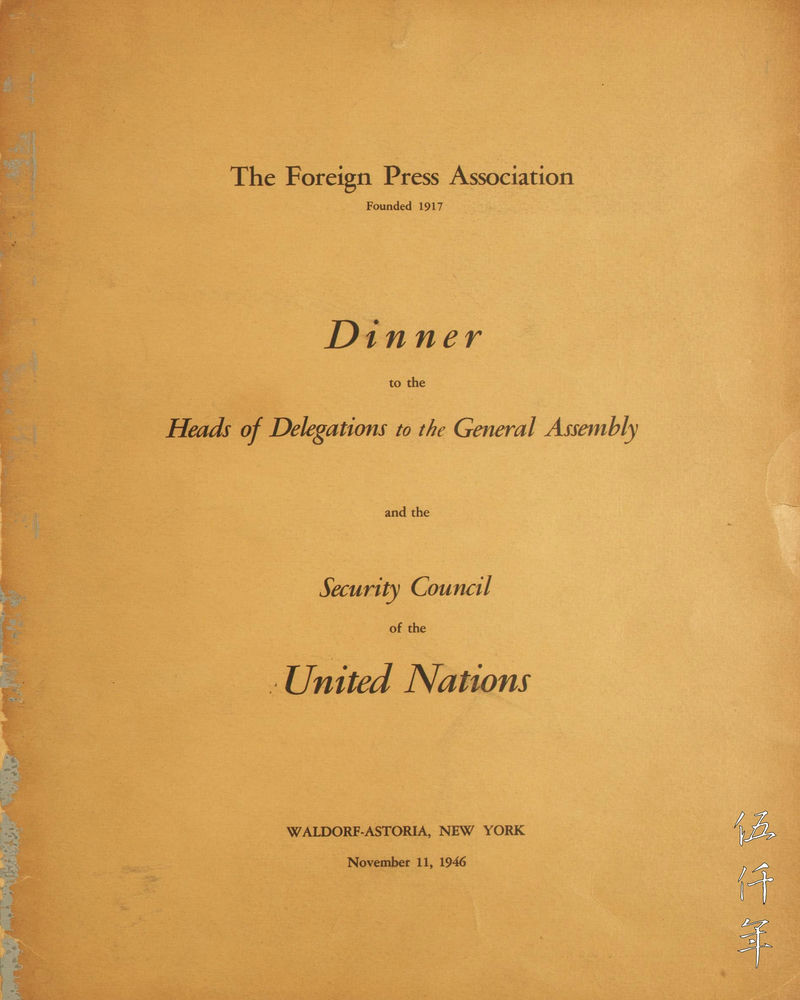
Front cover of the Dinner Programme for the head delegates to the United Nations General Assembly and the Security Council on 11th November 1946
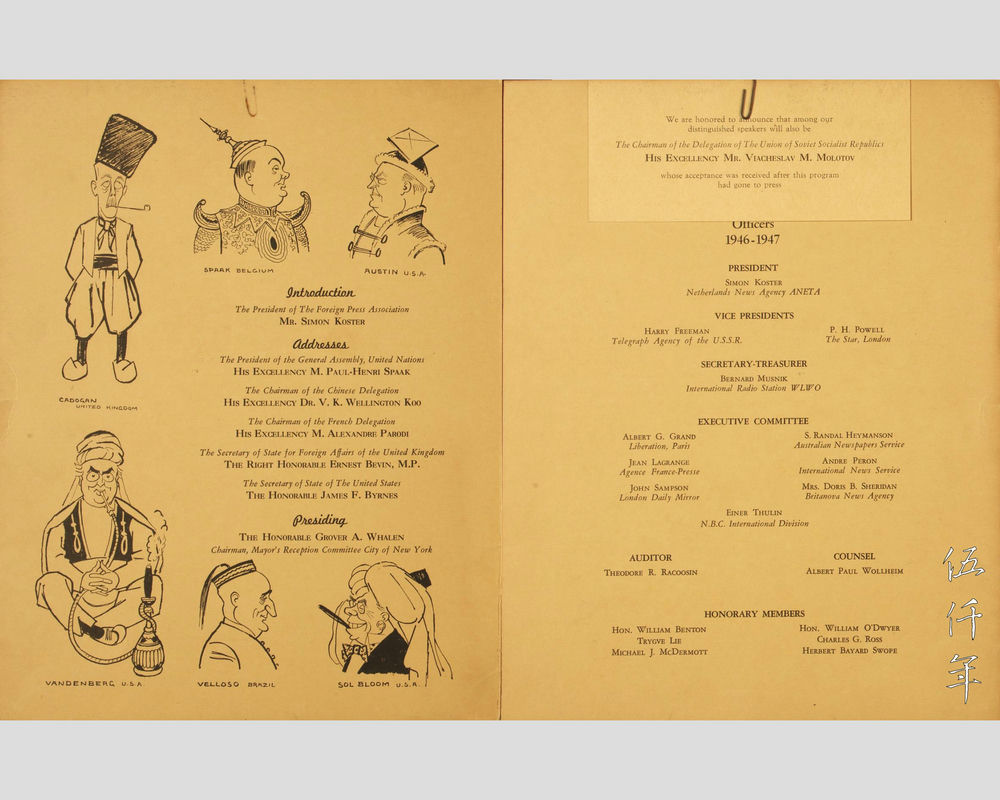
The inner left panel and the outer panel of the Dinner Programme
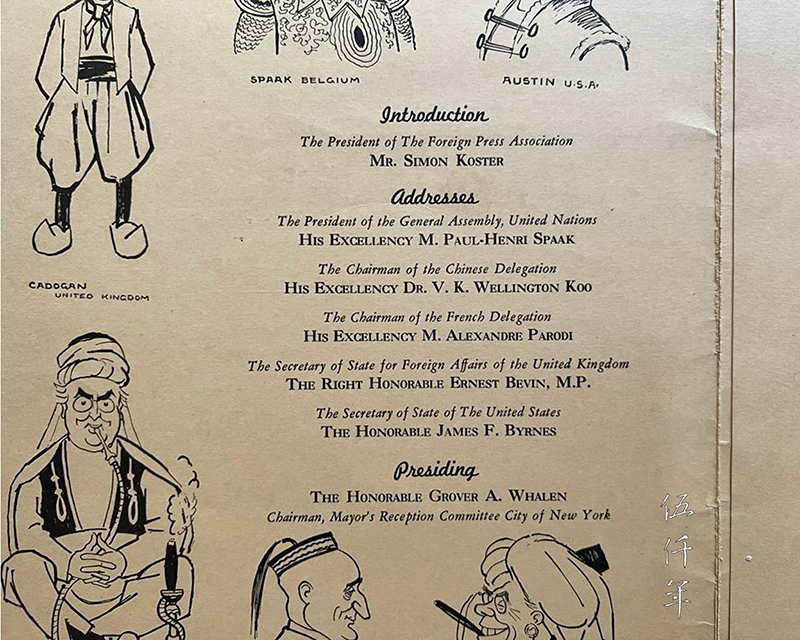
Printed on the inner left panel of the Dinner Programme is a list of host and guest speakers
Printed on the inner left panel of the Dinner Programme is a list of host and guest speakers. The order of speakers is as follows:
1. Simon Koster, President of the Foreign Press Association, host of the dinner.
2. Paul-Henri Spaak, President of the United Nations General Assembly.
3. Koo Vi Kyuin, Chairman of the Chinese Delegation.
4. Alexandre Parodi, Chairman of the French Delegation.
5. Ernest Bevin, Foreign Secretary of the United Kingdom.
6. James F. Byrnes, Secretary of State of the United States.
7. The name Viacheslav M. Molotov, Chairman of the Soviet Delegation was not printed on this panel. He accepted the invitation to speak only after the printing of the Dinner Programme, hence a separate card with his printed name was attached to the menu by a paper clip.
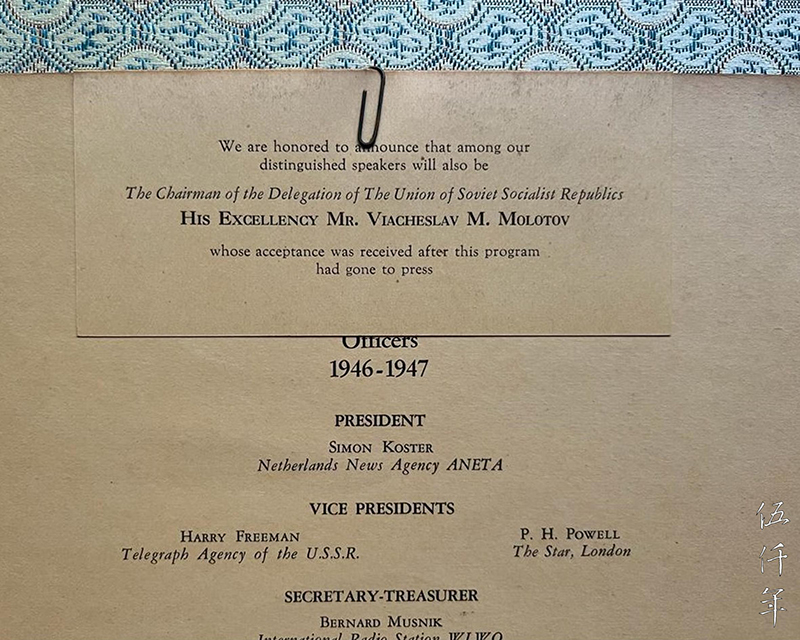
Viacheslav M. Molotov, Chairman of the Soviet Delegation, accepted the invitation to speak after the production of the Dinner Programme, hence a separate card with his name was attached to the Programme by a paper clip
After the addresses by Simon Koster, President of the Foreign Press Association, and Paul-Henry Spaak, President of the United Nations General Assembly, the speaker to follow was Koo Vi Kyuin, Chairman of the Chinese Delegation. The order of speakers at the dinner is ample testimony of the exalted international status and prestige of the Republic of China one year after the end of the Second World War.

Printed on the inner right panel of the Dinner Programme is the menu
Printed on the inner right panel of the Dinner Programme is the menu. It is rich in American flavours which pervade the dishes, dessert and wine that night.
The first course is Lobster and Crabmeat Louis.
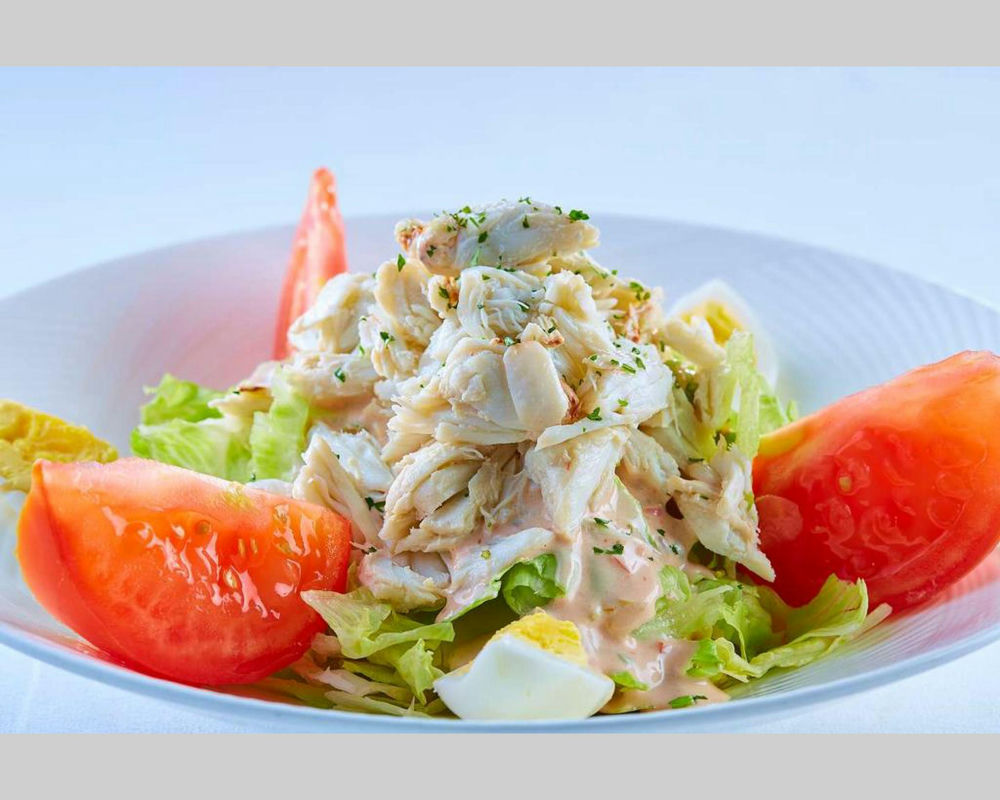
Lobster and Crabmeat Louis
The second course is Petite Marmite Henri IV.
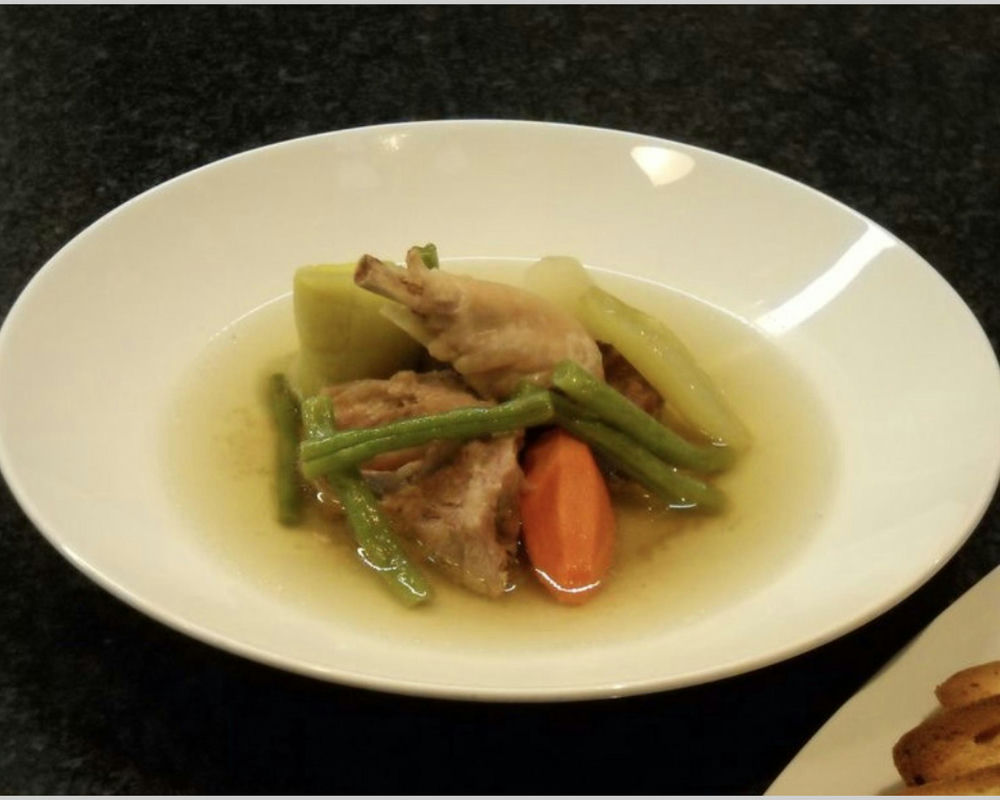
Petite Marmite Henri IV
The third course is Hearts of Celery, Ripe and Green Olives. The fourth course is Sirloin of Beef Chasseur, with small roasted potatoes and new spring beans sauté.
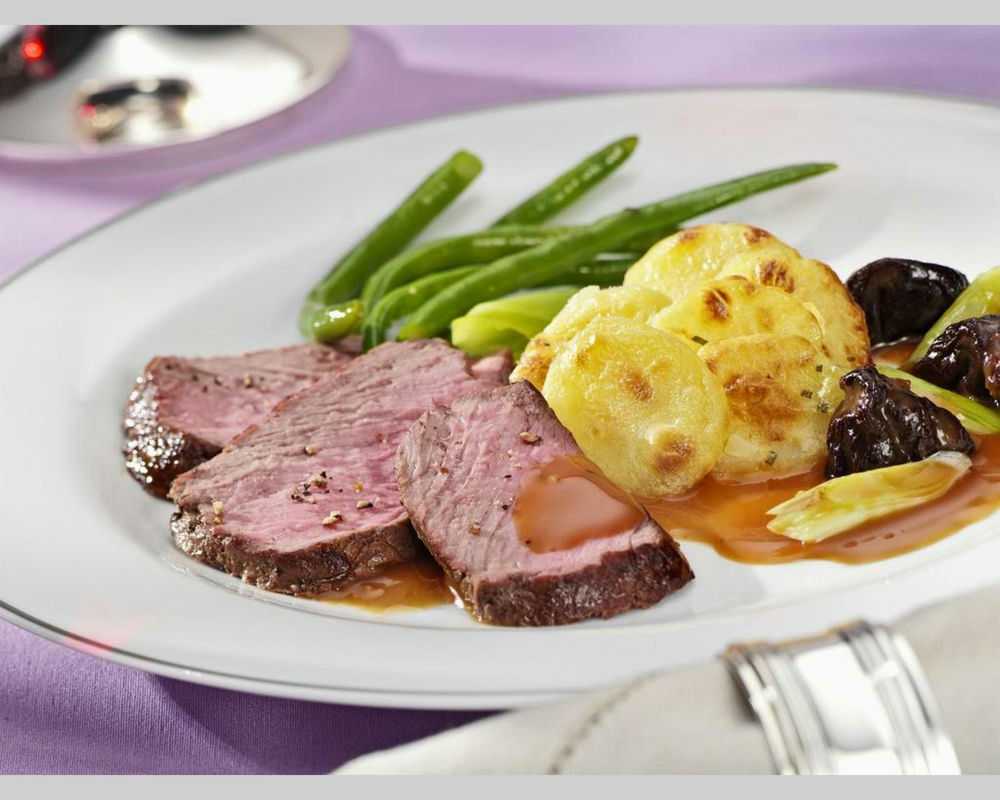
Sirloin of Beef Chasseur
The fifth course is Manhattan Rocher, with petite fours.
The sixth course is Demi Tasse, or coffee.
The wine offered was George de LaTour Private Reserve Cabernet 1940 from Napa Valley, California.

Exterior view of the Waldorf-Astoria Hotel in New York
The Waldorf-Astoria Hotel was built in 1931, and became a world famous venue for luxurious banquets and balls. It was forty seven storeys high, and kept the world record as the tallest building until 1963. Many of the United Nations luncheons and dinners for eminent diplomats and politicians were hosted here.
As for the illustrations depicted on the inner three panels of the Dinner Programme, there are altogether eighteen caricatures of delegates or representatives from numerous countries. They were drawn by Alois Derso and Emery Kelen. Each caricature dresses in the national costume of another country rather than his own, to emphasize and to acknowledge the essence of the English words at the top of the inner middle panel: “One World”. These words are a symbol for the world to come together as one, for countries to regard each other as one, for everyone to aspire to the concept of Universal Brotherhood.

Printed on the inner middle panel are six caricatures
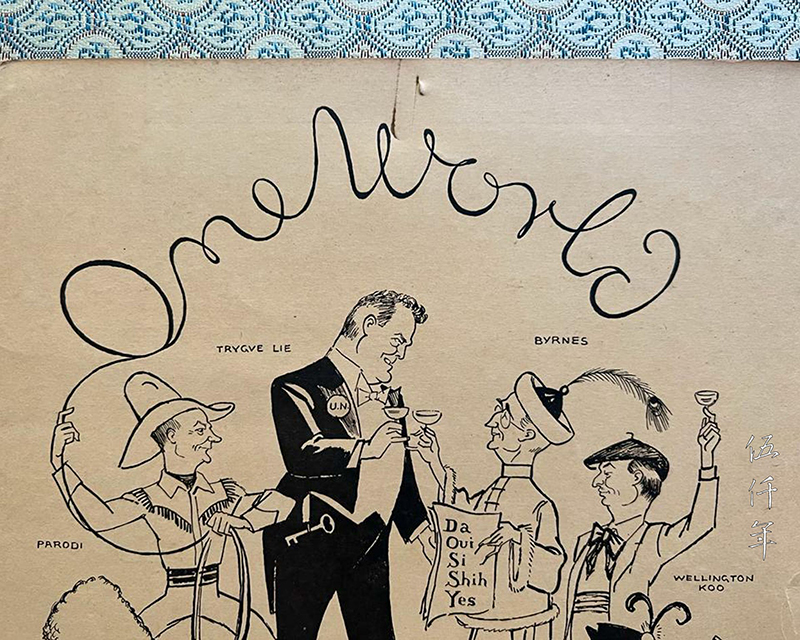
Printed at the top of the inner middle panel are the words “One World”
Printed on the inner middle panel of the Dinner Programme, there are six caricatures.
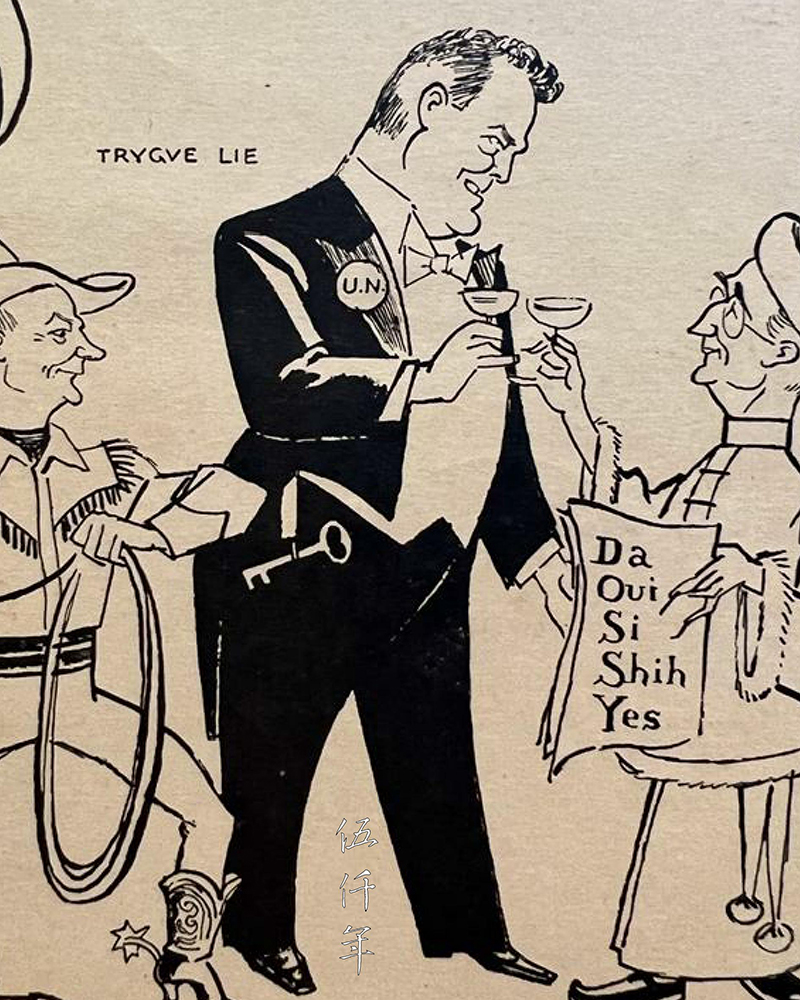
Caricature of Trygve Lie

Portrait of Trygve Lie
1. Trygve Lie, Secretary-General of the United Nations and former Foreign Minister of Norway, is attired in a dress coat.
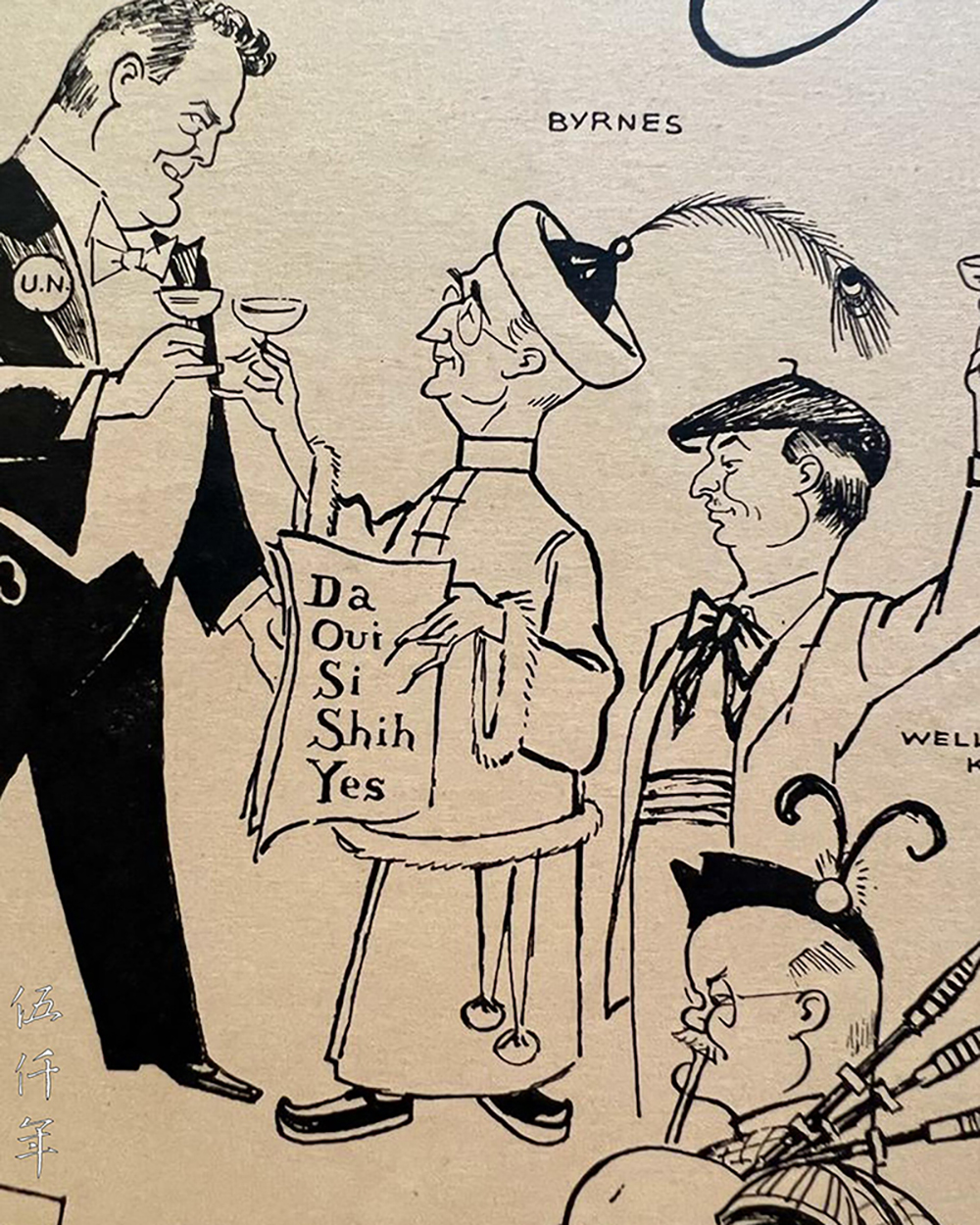
Caricature of James Francis Byrnes

Portrait of James Francis Byrnes
2. James Francis Byrnes, United States Secretary of State, is dressed in a Chinese costume. He holds a sheet with the word “Yes” written five times repeatedly according to the phonetic sounds of different languages. The first word “Da” means “Yes” for Russians, Croatians, Serbians, Bulgarians and Romanians. The second word “Oui” means “Yes” for French. The third word “Si” means “Yes” for Spanish and Italian. The fourth word “Shih” means “Yes” for Chinese. The fifth word “Yes” is for English speaking countries. The words are placed there to highlight universal support for the concept of “One World”.
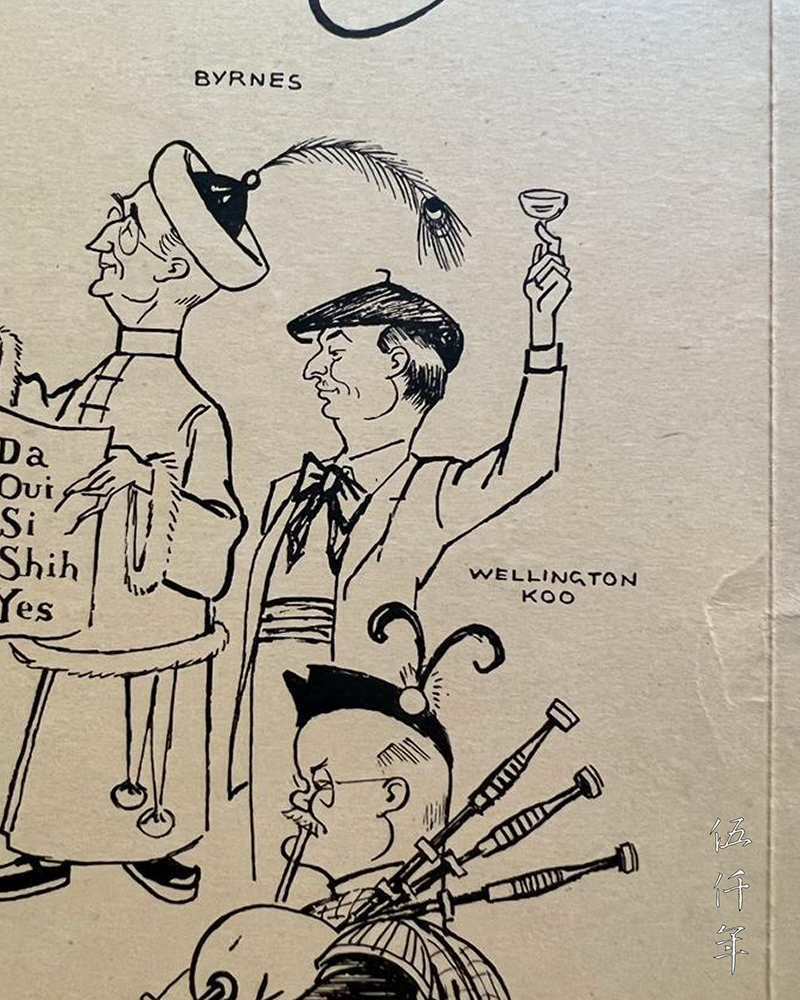
Caricature of Koo Vi Kyuin
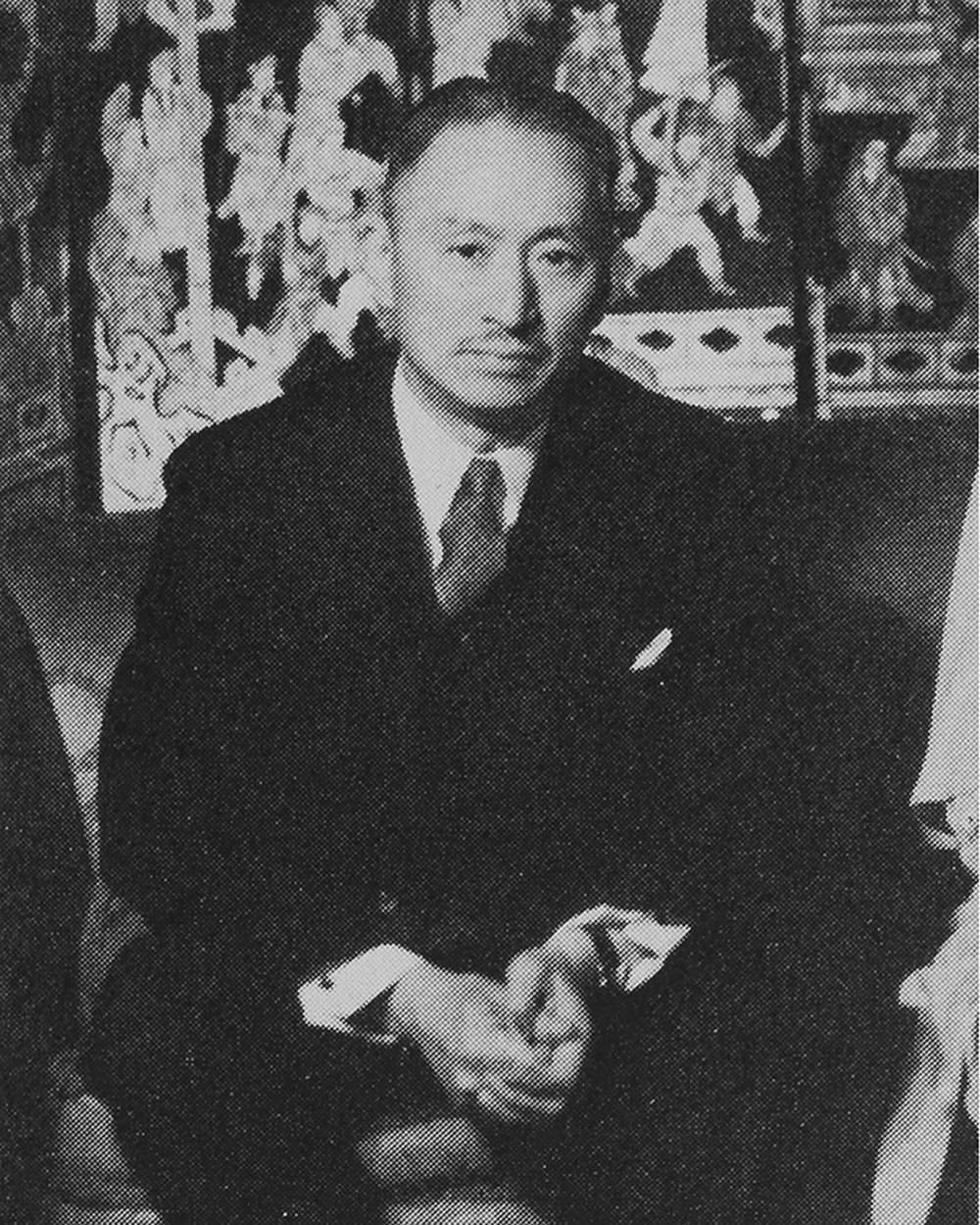
Portrait of Koo Vi Kyuin
3. Koo Vi Kyuin, Chairman of the Chinese Delegation, is dressed in a French costume.

Caricature of Alexandre Parodi
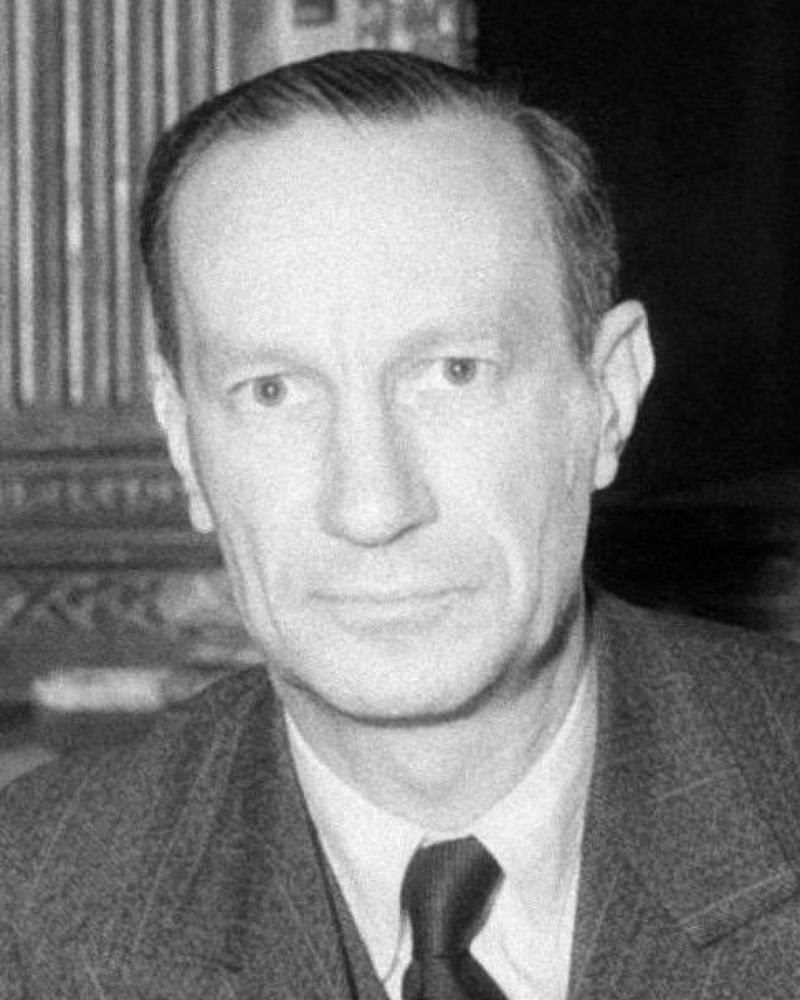
Portrait of Alexandre Parodi
4. Alexandre Parodi, Chairman of the French Delegation, is dressed in an American Western costume.

Caricature of Viacheslav M. Molotov

Portrait of Viacheslav M. Molotov
5. Viacheslav M. Molotov, Chairman of the Soviet Delegation and Foreign Minister, is dressed in a Scottish costume.

Caricature of Ernest Bevin
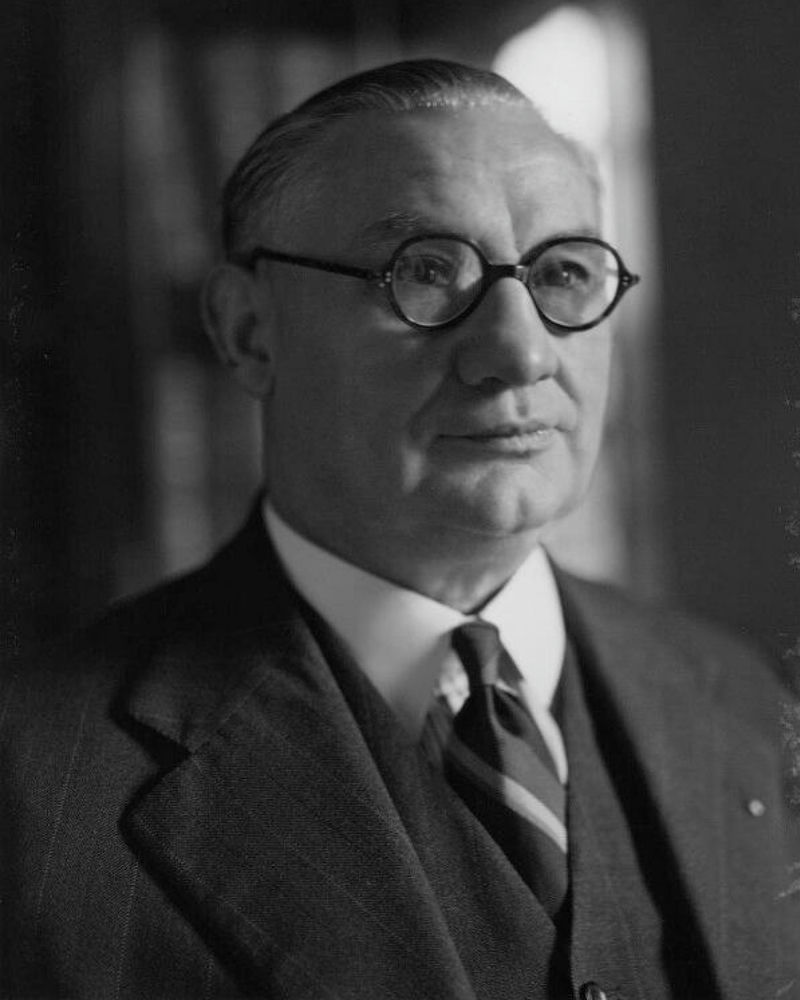
Portrait of Ernest Bevin
6. Ernest Bevin, British Foreign Secretary, is dressed in a Soviet costume.

Printed on the inner right panel are six more caricatures
Printed on the inner right panel of the Dinner Programme, there are another six caricatures.
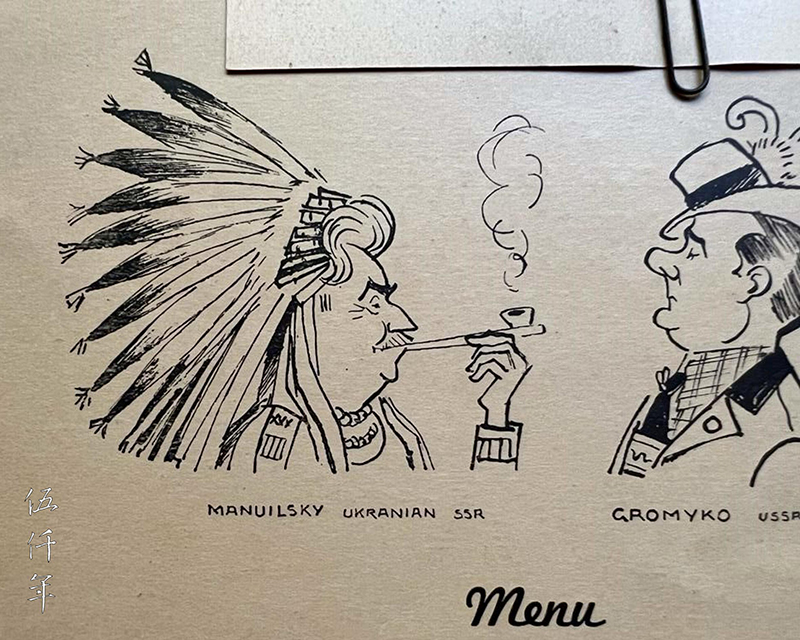
Caricature of Dmitry Manuilsky
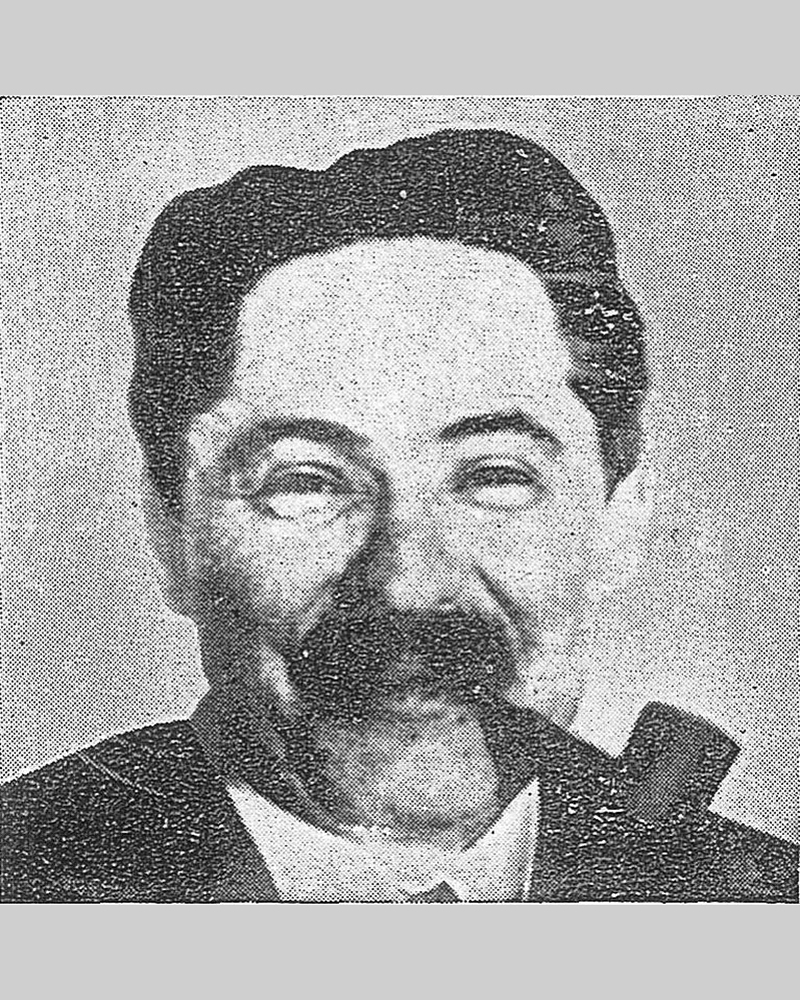
Portrait of Dmitry Manuilsky
7. Dmitry Manuilsky, Permanent Representative of the Ukrainian Delegation, is dressed in an American Indian costume.
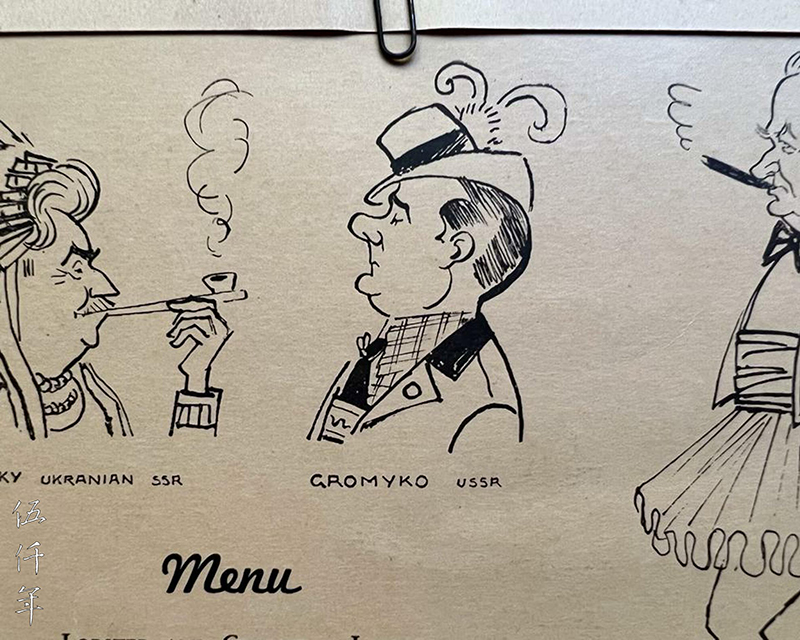
Caricature of Andrei Gromyko

Portrait of Andrei Gromyko
8. Andrei Gromyko, Permanent Representative of the Soviet Delegation, is dressed in an Austrian costume.
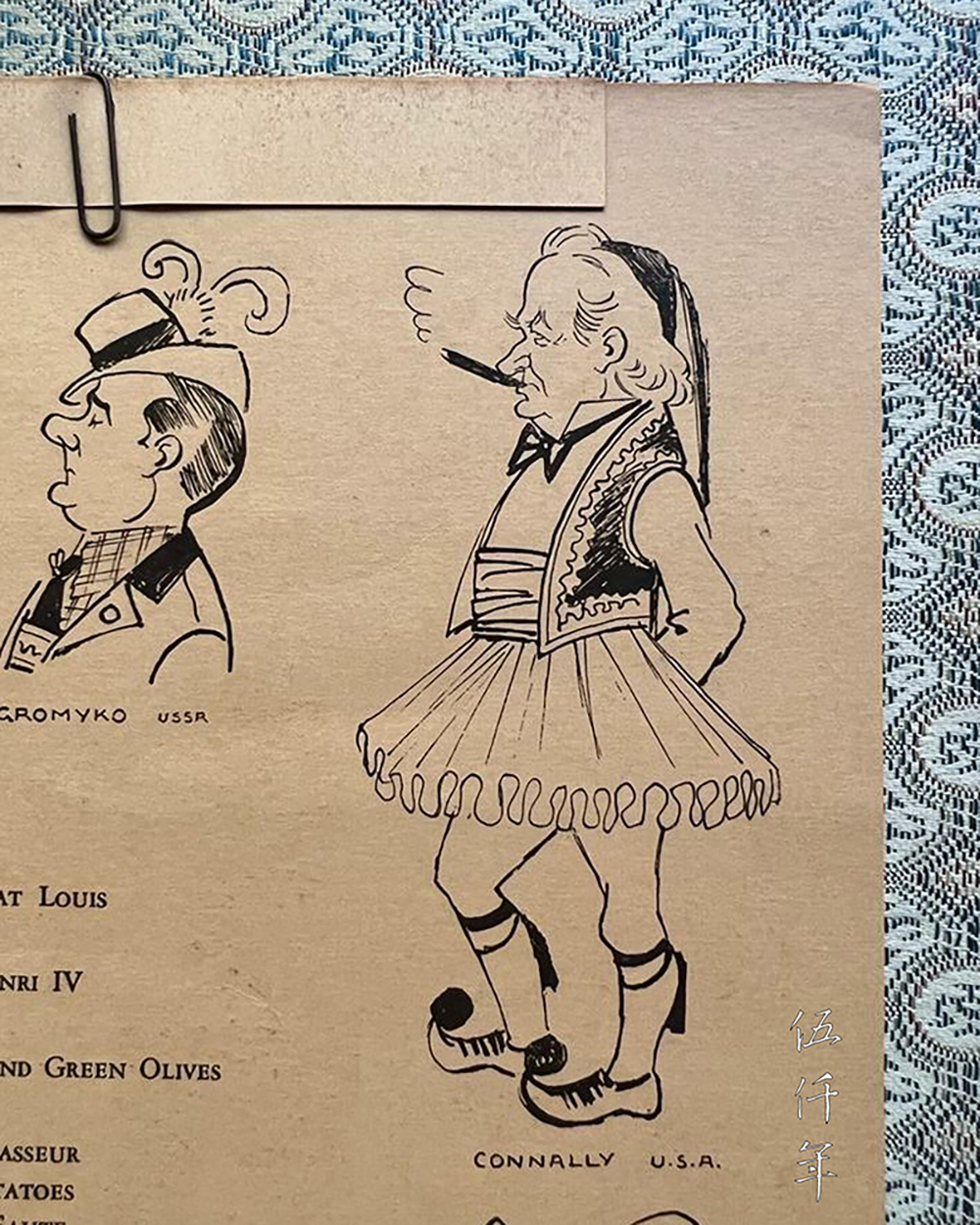
Caricature of Tom Connolly
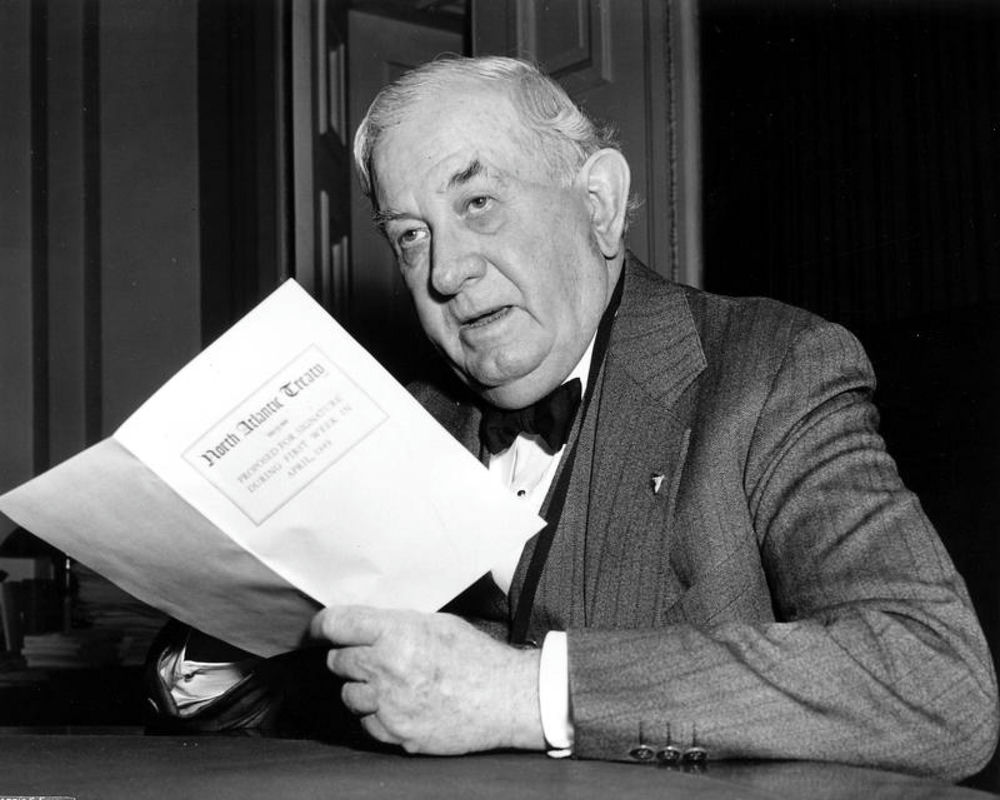
Portrait of Tom Connolly
9. Tom Connolly, First Delegate of the United States Delegation and Senator, is dressed in a Greek costume.
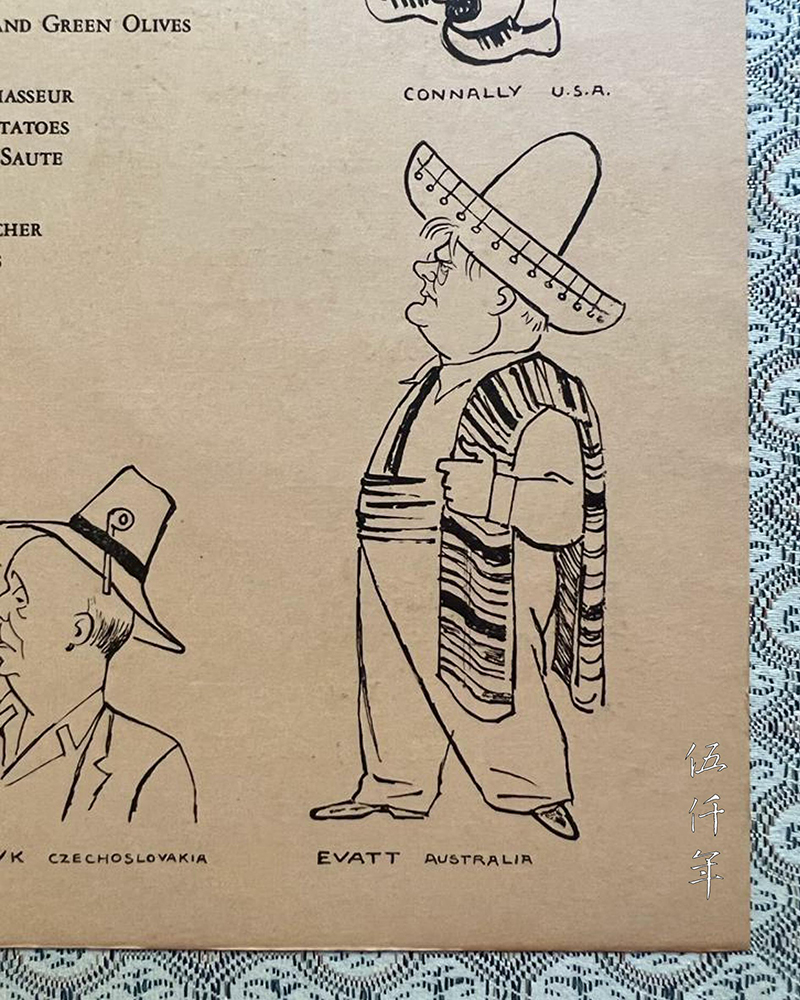
Caricature of Herbert Vere Evatt
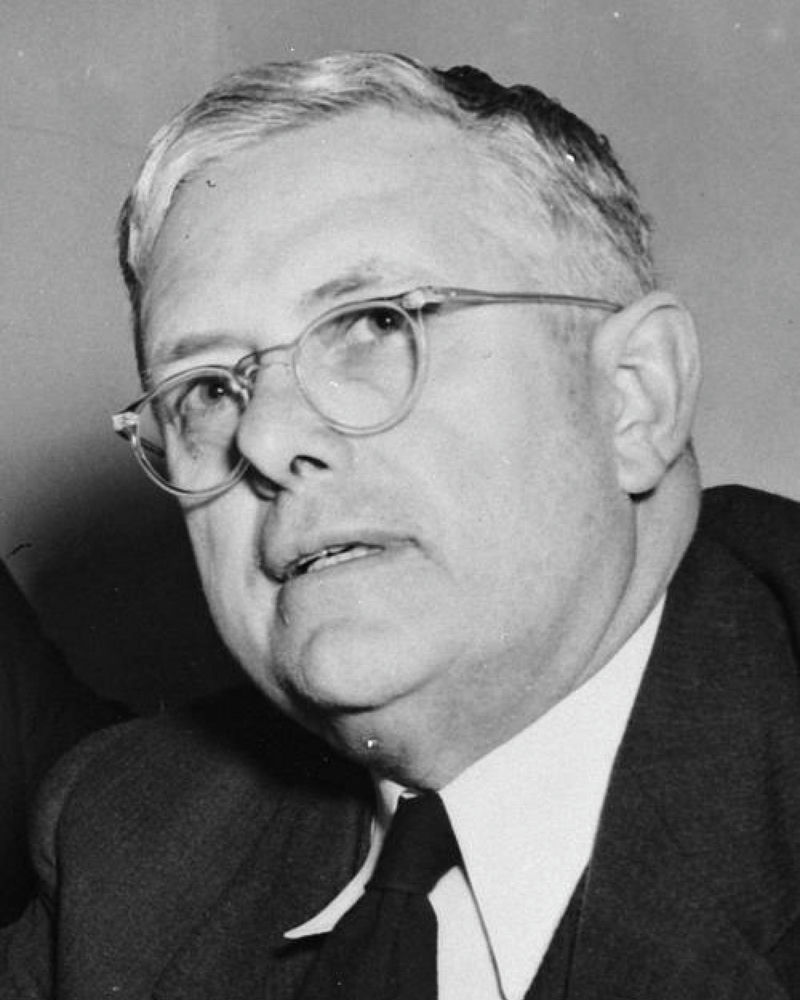
Portrait of Herbert Vere Evatt
10. Herbert Vere Evatt, Chairman of the Australian Delegation and Minister for External Affairs, is dressed in a Mexican costume.
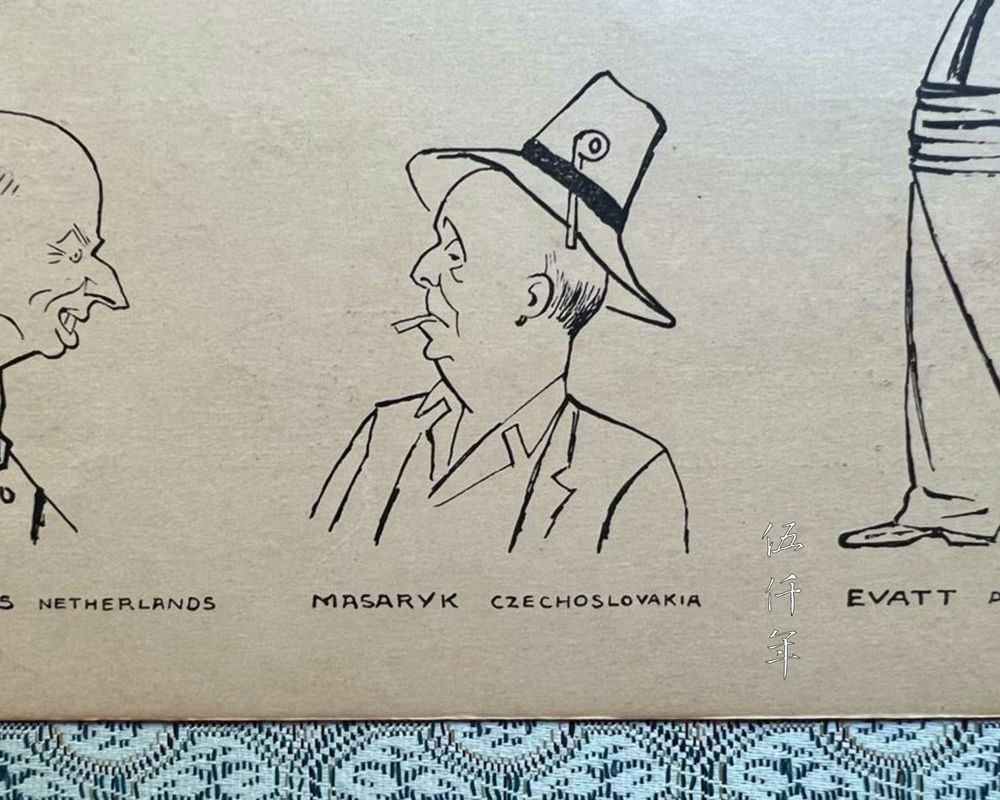
Caricature of Jan Masaryk

Portrait of Jan Masaryk
11. Jan Masaryk, Chairman of the Czech Delegation and Foreign Minister, is dressed in a Swiss costume.

Caricature of Eelco van Kleffens
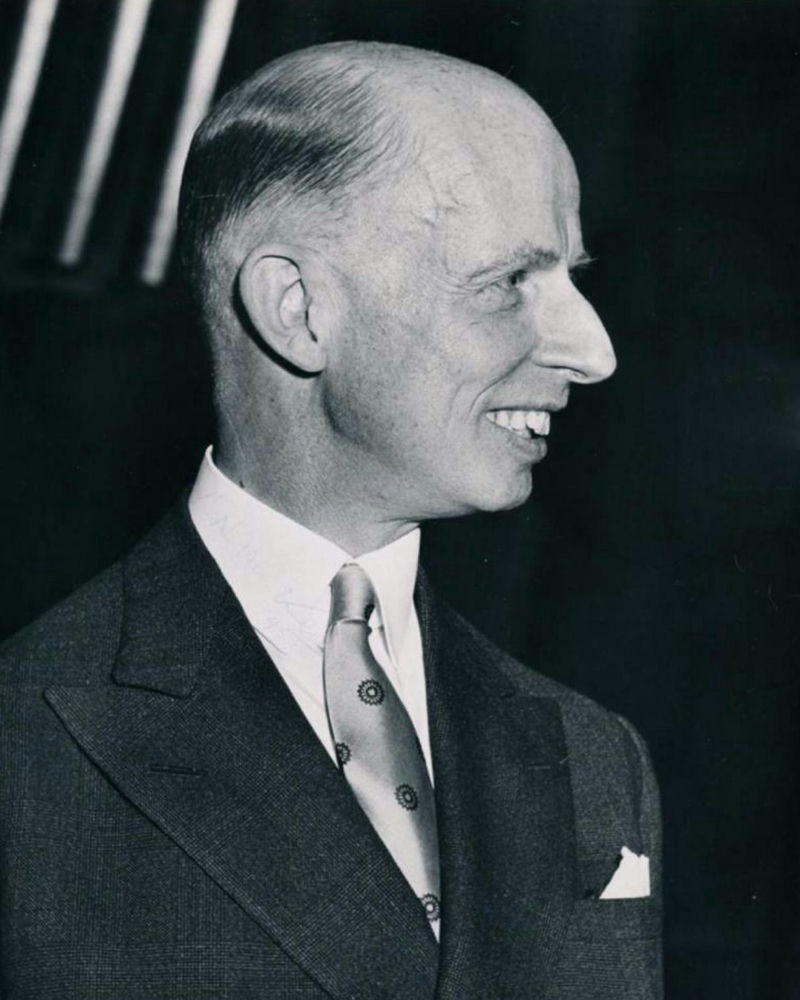
Portrait of Eelco van Kleffens
12. Eelco van Kleffens, Permanent Representative of the Dutch Delegation, is dressed in a Turkish costume.
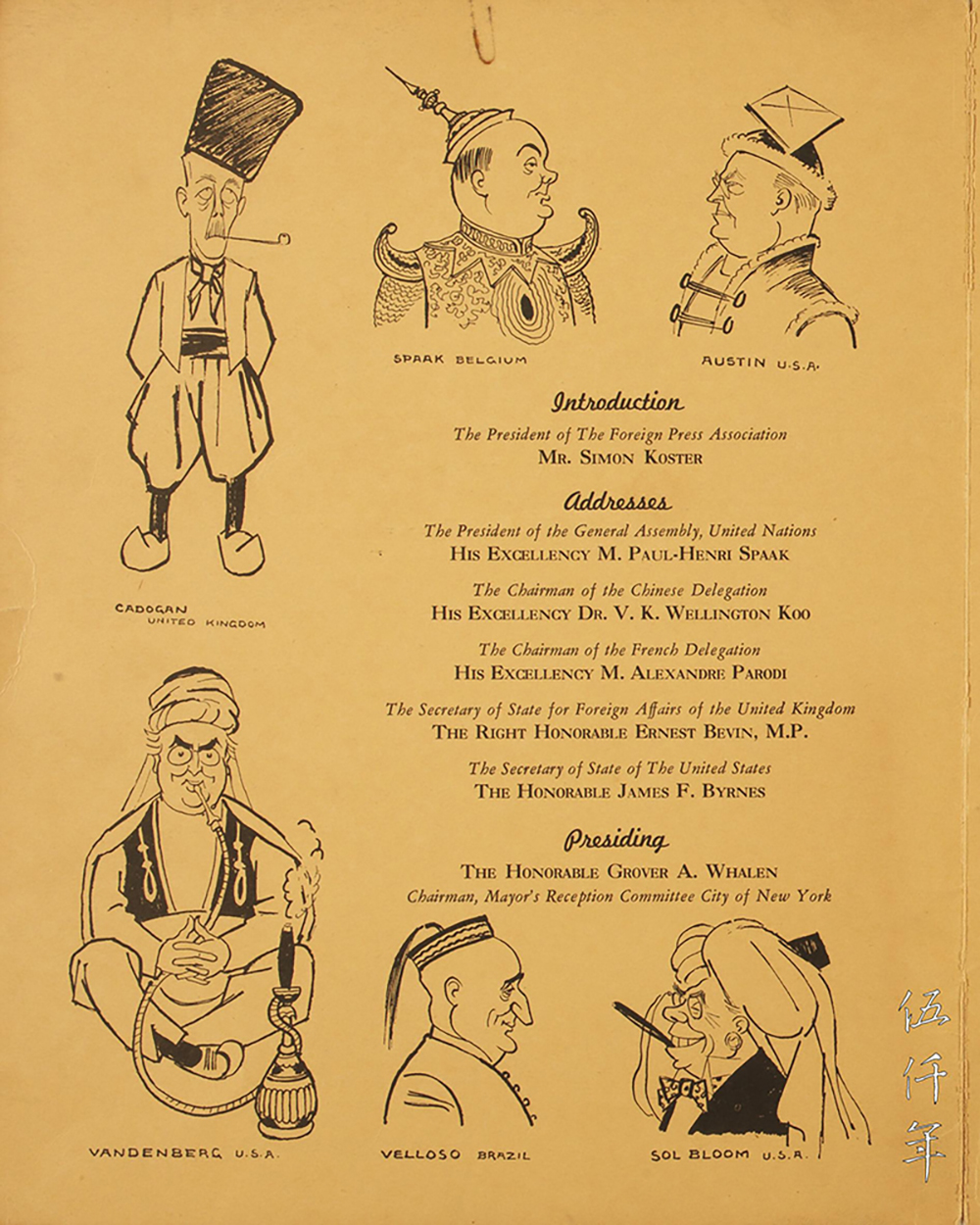
Printed on the inner left panel are another six caricatures
Printed on the inner left panel of the Dinner Programme, there are six more caricatures.

Caricature of Warren Robinson Austin
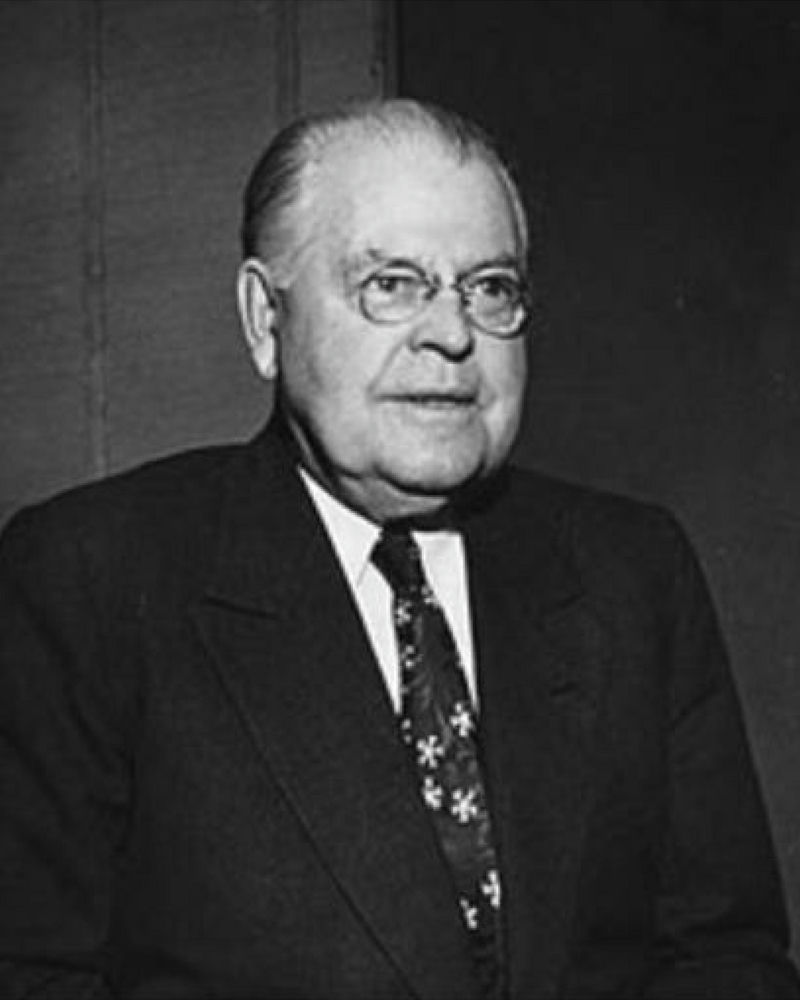
Portrait of Warren Robinson Austin
13. Warren Robinson Austin, American Ambassador to the United Nations, is dressed in a Polish costume.
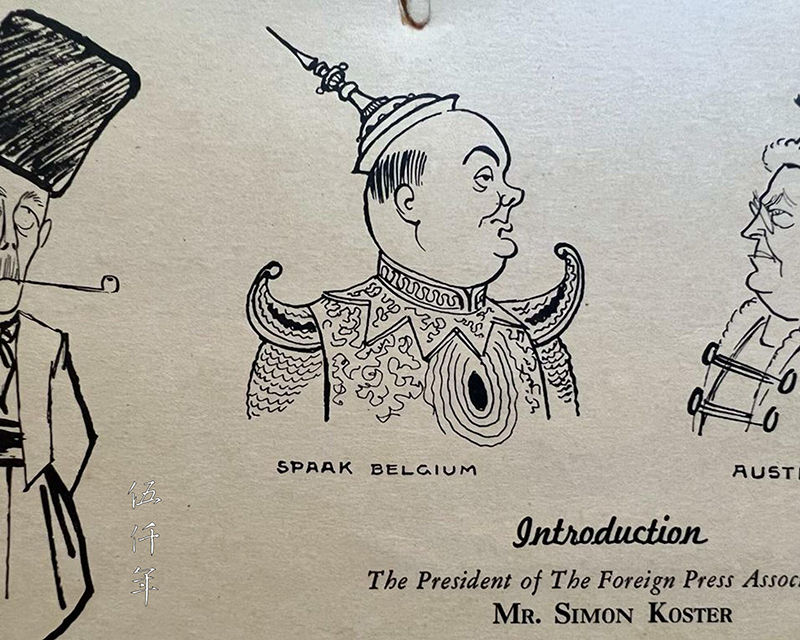
Caricature of Paul-Henry Spaak

Portrait of Paul-Henry Spaak
14. Paul-Henry Spaak, President of the United Nations General Assembly and Foreign Minister of Belgium, is dressed in a Thai costume.
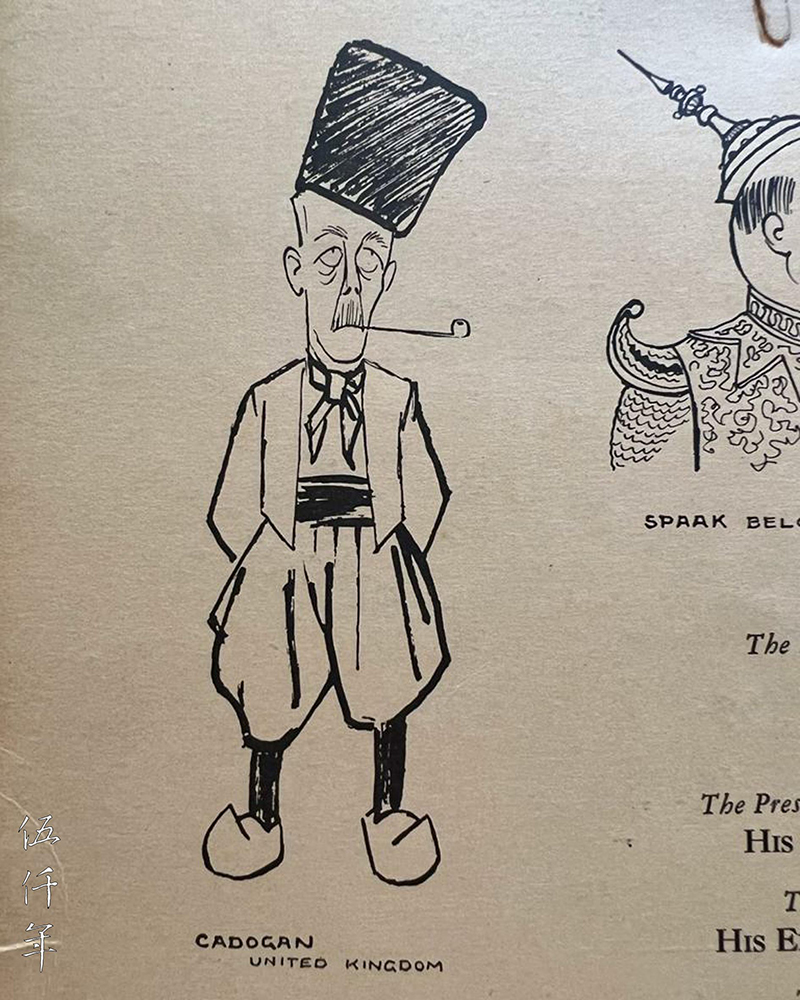
Caricature of Sir Alexander Cadogan
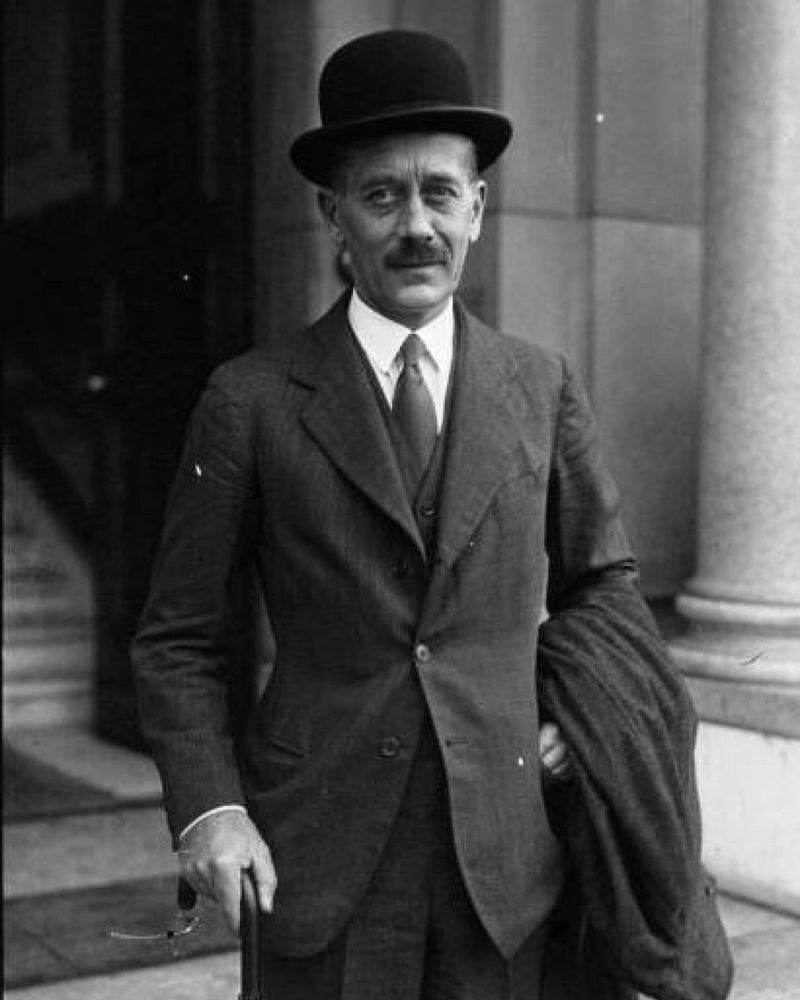
Portrait of Sir Alexander Cadogan
15. Sir Alexander Cadogan, British Permanent Representative to the United Nations, is dressed in a Dutch costume.
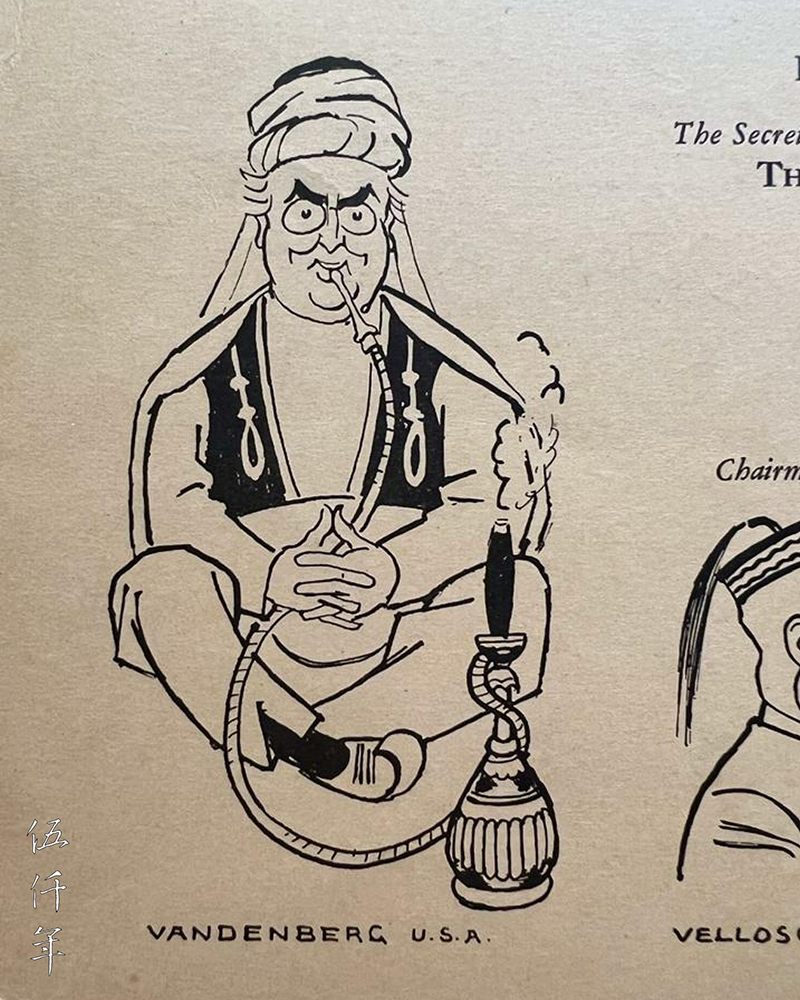
Caricature of Arthur Vandenberg
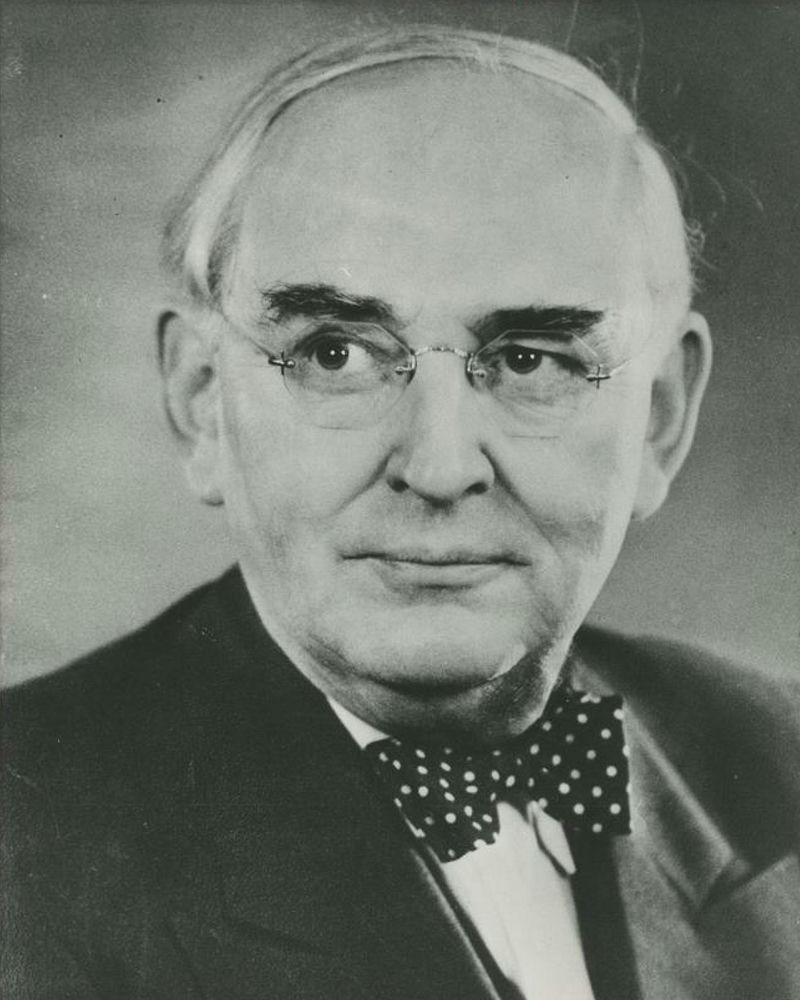
Portrait of Arthur Vandenberg
16. Arthur Vandenberg, Delegate of the United States Delegation and Senator, is dressed in a Syrian costume.

Caricature of Predo Leao Velloso

Portrait of Predo Leao Velloso
17. Predo Leao Velloso, Chairman of the Brazilian Delegation, is dressed in an Egyptian costume.
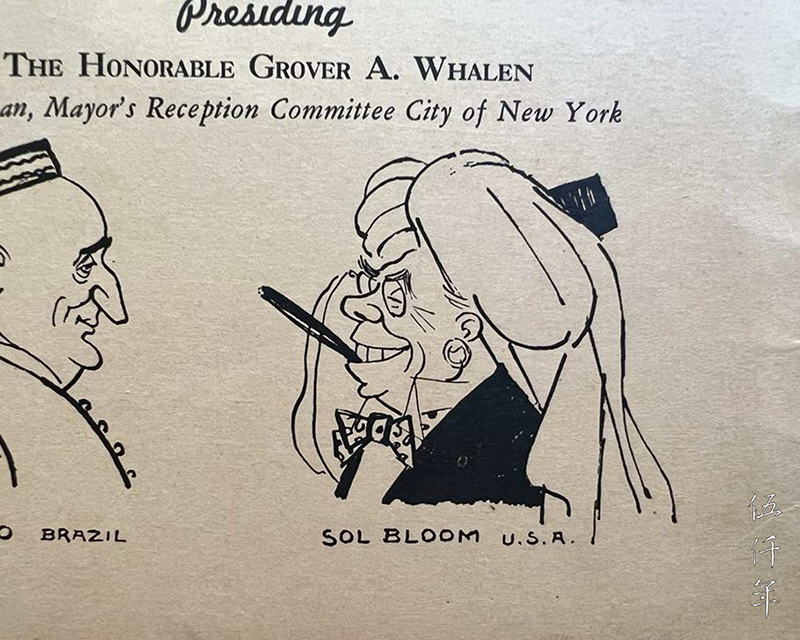
Caricature of Sol Bloom

Portrait of Sol Bloom
18. Sol Bloom, Chairman of the United States House Committee on Foreign Affairs and Member of the House of Representative, is dressed in an Indian costume.

Alois Derso (right), Charles Malik (centre, Cuban delegate) and Emery Kelen (left), at the headquarters of the United Nations. Photograph taken on 24th April 1950. Photograph courtesy United Nations Media Centre.
The illustration artists Alois Derso (1888-1964) and Emery Kelen (1896-1978) were both Hungarians who collaborated together in their artistic endeavors. During the period of 1920 to 1930, they were renowned for using cartoons and caricatures to chronicle and deride political and diplomatic events. They both worked as reporters for the League of Nations in Geneva. With the rise of antisemitism in Germany, they fled to the United States at the end of 1938. In 1948 they went their separate ways and dissolved their collaboration. In 1950, a compilation of their past works was published under the title A Cartoon History of the United Nations.

Signatures of Alois Derso and Emery Kelen at the lower right corner of the inner middle panel
It is not known to whom this Dinner Programme previously belonged. It should be the property of someone who attended the dinner on 11th November 1946, who was also interested in history and autographs. Perhaps the person was a member of the Foreign Press Association. At that time, the Republic of China was one of the four founding members of the United Nations. Koo Vi Kyuin was the Chairman of the Chinese Delegation and Ambassador to the United States. For him to be the first person to sign his autograph on the back of the Dinner Programme was congruous with the order of speakers at the dinner. Perusing his autograph summons the distant memory of 1945, when Koo Vi Kyuin led the delegates from all member countries to sign the United Nations Charter. After the Second World War, the Republic of China was in her finest moment. Nations in the West still regarded China as a country that epitomized the ancient Confucian civilization. Chinese diplomats were among the finest men of their generation, steeped in learning and fortified by rectitude. Koo Vi Kyuin was himself celebrated internationally. Harking back to the past and contemplating the present, disconsolations are certain to be ceaseless. We can nonetheless seek inspirations in ancient historical stories, that of Tsu-ti (祖逖), a military general of the Chin dynasty (266-420), who beat his oar in the middle of the river crossing and swore never to return until the recovery of China lost, that of Kuang-wu Emperor (光武帝) who restored the Han dynasty (202BC-220AD) from chaos and reinstated the propriety of China past. We can aspire to seek that China lost.
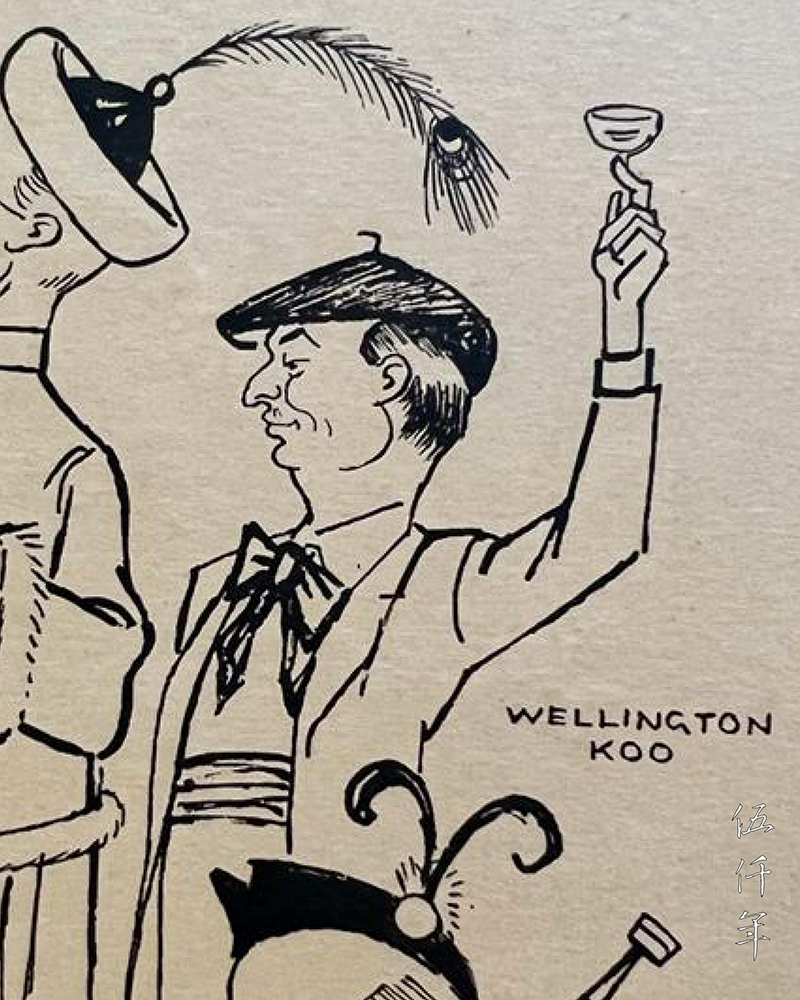
A detail of the caricature of Koo Vi Kyuin, Chairman of the Delegation for the Republic of China
